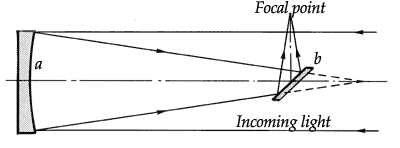 ne of the more interesting reasons for collecting antique telescopes is being able to view the world and the heavens
just as our ancestors saw them. In the photo above, the author views the roofs of old Inverness through an early
nineteenth-century five-draw refractor with a rosewood body. Old optics are uncoated and often less optically
clear than modern glass. It's as if you are viewing the world through the faint veil of history. ne of the more interesting reasons for collecting antique telescopes is being able to view the world and the heavens
just as our ancestors saw them. In the photo above, the author views the roofs of old Inverness through an early
nineteenth-century five-draw refractor with a rosewood body. Old optics are uncoated and often less optically
clear than modern glass. It's as if you are viewing the world through the faint veil of history. |
 |
The collector of historical instruments needs to know the difference between the two basic types of instruments. These will be explored
in more detail in other other sections of this website. Here's the least you need to know:
 The refracting telescope works by focusing the light rays on a plane called the "focal point"
(actually several points very close together). The main, or objective lens can be a two-element doublet, as in the illustration here, or a single lens. A single lens does a poor job
of getting all the colors to focus close together. Most very early telescopes had a single objective lens with a lot of false color. The
achromatic doublet wasn't in use until after about 1750. An eyepiece is placed at the focal point, where the image is focused. It is the job
of the eypiece to magnify the image. The objective lens determines the light-gathering capability of the scope. The larger the objective and the
more light that is gathered, the more magnification that may be used. Very early refractors were limited to about 2 inches in aperture.
The refracting telescope works by focusing the light rays on a plane called the "focal point"
(actually several points very close together). The main, or objective lens can be a two-element doublet, as in the illustration here, or a single lens. A single lens does a poor job
of getting all the colors to focus close together. Most very early telescopes had a single objective lens with a lot of false color. The
achromatic doublet wasn't in use until after about 1750. An eyepiece is placed at the focal point, where the image is focused. It is the job
of the eypiece to magnify the image. The objective lens determines the light-gathering capability of the scope. The larger the objective and the
more light that is gathered, the more magnification that may be used. Very early refractors were limited to about 2 inches in aperture.
 Sir Isaac Newtons's invention, the reflecting telescope, solved a number of problems. By using a
mirror to gather and focus the light, and eliminating lenses altogether, the constituent colors of light are all focused at the same point.
A curved mirror could be made much larger than a refracting lens, allowing the instrument to gather more light. More light means a higher
magnification may be used and more detail may be seen. For more on this, see 17th-Century Telescopes.
Sir Isaac Newtons's invention, the reflecting telescope, solved a number of problems. By using a
mirror to gather and focus the light, and eliminating lenses altogether, the constituent colors of light are all focused at the same point.
A curved mirror could be made much larger than a refracting lens, allowing the instrument to gather more light. More light means a higher
magnification may be used and more detail may be seen. For more on this, see 17th-Century Telescopes.
There are other variations of reflector assembly. These will be introduced where appropriate to the instrument. For the purposes of this
website, it is the difference between a reflector and refractor that must be understood.
 ne of the more interesting reasons for collecting antique telescopes is being able to view the world and the heavens
just as our ancestors saw them. In the photo above, the author views the roofs of old Inverness through an early
nineteenth-century five-draw refractor with a rosewood body. Old optics are uncoated and often less optically
clear than modern glass. It's as if you are viewing the world through the faint veil of history.
ne of the more interesting reasons for collecting antique telescopes is being able to view the world and the heavens
just as our ancestors saw them. In the photo above, the author views the roofs of old Inverness through an early
nineteenth-century five-draw refractor with a rosewood body. Old optics are uncoated and often less optically
clear than modern glass. It's as if you are viewing the world through the faint veil of history.
 The refracting telescope works by focusing the light rays on a plane called the "focal point"
(actually several points very close together). The main, or objective lens can be a two-element doublet, as in the illustration here, or a single lens. A single lens does a poor job
of getting all the colors to focus close together. Most very early telescopes had a single objective lens with a lot of false color. The
achromatic doublet wasn't in use until after about 1750. An eyepiece is placed at the focal point, where the image is focused. It is the job
of the eypiece to magnify the image. The objective lens determines the light-gathering capability of the scope. The larger the objective and the
more light that is gathered, the more magnification that may be used. Very early refractors were limited to about 2 inches in aperture.
The refracting telescope works by focusing the light rays on a plane called the "focal point"
(actually several points very close together). The main, or objective lens can be a two-element doublet, as in the illustration here, or a single lens. A single lens does a poor job
of getting all the colors to focus close together. Most very early telescopes had a single objective lens with a lot of false color. The
achromatic doublet wasn't in use until after about 1750. An eyepiece is placed at the focal point, where the image is focused. It is the job
of the eypiece to magnify the image. The objective lens determines the light-gathering capability of the scope. The larger the objective and the
more light that is gathered, the more magnification that may be used. Very early refractors were limited to about 2 inches in aperture. Sir Isaac Newtons's invention, the reflecting telescope, solved a number of problems. By using a
mirror to gather and focus the light, and eliminating lenses altogether, the constituent colors of light are all focused at the same point.
A curved mirror could be made much larger than a refracting lens, allowing the instrument to gather more light. More light means a higher
magnification may be used and more detail may be seen. For more on this, see
Sir Isaac Newtons's invention, the reflecting telescope, solved a number of problems. By using a
mirror to gather and focus the light, and eliminating lenses altogether, the constituent colors of light are all focused at the same point.
A curved mirror could be made much larger than a refracting lens, allowing the instrument to gather more light. More light means a higher
magnification may be used and more detail may be seen. For more on this, see